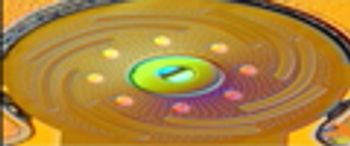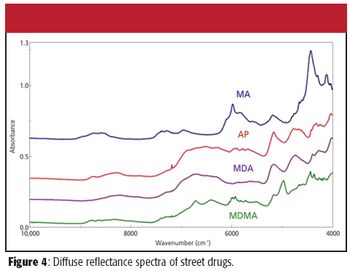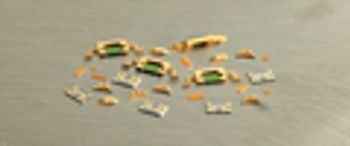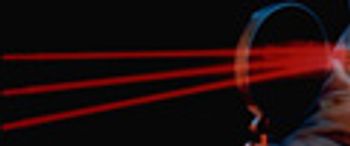
An interview with Charles Wilkins, the winner of the 2013 American Chemical Society Division of Analytical Chemistry Award in Chemical Instrumentation, sponsored by the Dow Chemical Company.

An interview with Charles Wilkins, the winner of the 2013 American Chemical Society Division of Analytical Chemistry Award in Chemical Instrumentation, sponsored by the Dow Chemical Company.

Simulated leaf spectral data were generated to analyze scattering impact and then compared to experimental data to validate the conclusions of the simulation.

Part II of this series described many of the miniature optical technologies that were developed as a result of the telecommunications boom, and Part III covered conventional small near-infrared (NIR) spectrometers. Here, in Part IV, we bring those themes together and see how the massive investment in telecommunications, microelectro- mechanical systems (MEMS), and micro-opto-electro-mechanical (MOEMS) is starting to impact NIR spectroscopy.

Canadian researchers at the Bloorview Research Institute (Toronto, ON, Canada) and the University of Toronto have developed a way to use optical imaging to decode preference by measuring the intensity of near-infrared light absorbed in brain tissue.

Using a powerful new image-processing technique, researchers at the University of Toronto (Ontario, Canada) have identified an exoplanet in images taken in 1998 with the Hubble Space Telescope's Near-Infrared Camera and Multi-Object Spectrometer (NICMOS).

Japan's Honda Research Institute and precision-equipment manufacturer Shimadzu recently demonstrated a technology that allows humans to control a robot through thought alone.

The authors discuss the use of FT-NIR to identify several different types of drug formulations.

In Part I of this series, we examined recently developed miniature mid-infrared spectrometers (1). In Part II, we surveyed micro electro mechanical systems (MEMS), micro-opto-electro-mechanical systems (MOEMS), and some of the photonics technologies developed for optical communications (2). Here, in Part III, we summarize some of the conventional approaches to miniaturizing near-infrared (NIR) spectrometers, and in Part IV, we will bring these themes together and see how MOEMS and telecommunications photonics are poised to revolutionize NIR spectroscopy with a new generation of miniature instruments.



This month's Technology Forum looks at the topic of FT-IR/NIR spectroscopy and the trends and issues surrounding it. Joining us for this discussion are Rohit Bhargava, with the University of Illinois, Chris Petty, with Thermo Fisher Scientific, Jim Yano and John Beauchaine, with Aspectrics, Richard Larsen, with Jasco, Inc., and Alan Rein, with A2 Technologies.

For ethanol to be usable as a fuel, water must be removed in the distillation process. This article reviews an experiment conducted to test the capability of an EP-IR spectrometer to quantify the percentage volume of water in ethanol.

This article compares three regulatory standards for near-infrared wavelength references and then reviews currently available materials. Reference types discussed include gas and vapor band spectra, solid artifacts in both transmittance and reflectance, and liquids in transmittance. Traceability issues are discussed in connection with calibration and qualification regulatory compliance requirements, particularly for the pharmaceutical and medical device industries.

NIR chemical imaging provides a rapid method for detecting and comparing suspected counterfeit pharmaceutical products with no sample preparation.

November 2006. The authors demonstrate the use of NIR-CI for simultaneous measurement of content uniformity for multiple tablets and discuss some advantages of this approach.

Here the authors determine the content of ecdsterone in the Chinese herb Niuxi using near-infrared diffuse reflection spectroscopy and the partial least squares correlation. Compared to existing methods, they contend that their approach is easier, quicker, cheaper, and less environmentally harmful.

Here the author compares near-infrared to mid-infrared as analytical tool in process management. he weighs the pros and cons of both spectral regions and suggests general applications for which one or the other is better suited.

Tunable diode laser absorption spectroscopy (TDLAS) has evolved from a laboratory specialty technique to the foundation for highly sensitive and specific gas-phase sensors for the process environment. This article discusses two recently developed products, a portable trace gas monitor, and a water vapor flow sensor.

The authors describe implementation and performance of a miniaturized NIR analyzer and associated chemometric techniques applied to the monitoring of a drying process for active pharmaceutical ingredients (APIs).

NIR-CI adds a completely new dimension to conventional NIR spectroscopy.

Encoded photometric technology has the ability to address the demands of modern process applications, including those of the PAT initiative.

This article summarizes recent efforts by the Duquesne University Center for Pharmaceutical Technology to develop and validate a PAT method using NIR spectroscopy for the on-line prediction of tablet hardness and active pharmaceutical ingredient content.

This article summarizes recent efforts by the Duquesne University Center for Pharmaceutical Technology to develop and validate a PAT method using NIR spectroscopy for the on-line prediction of tablet hardness and active pharmaceutical ingredient content.

Near-infrared spectroscopy moves into warehouses to check incoming drug substances, excipients, and packaging materials, and onto the production floor to monitor characteristics such as blend uniformity, moisture content, and dissolution rate.